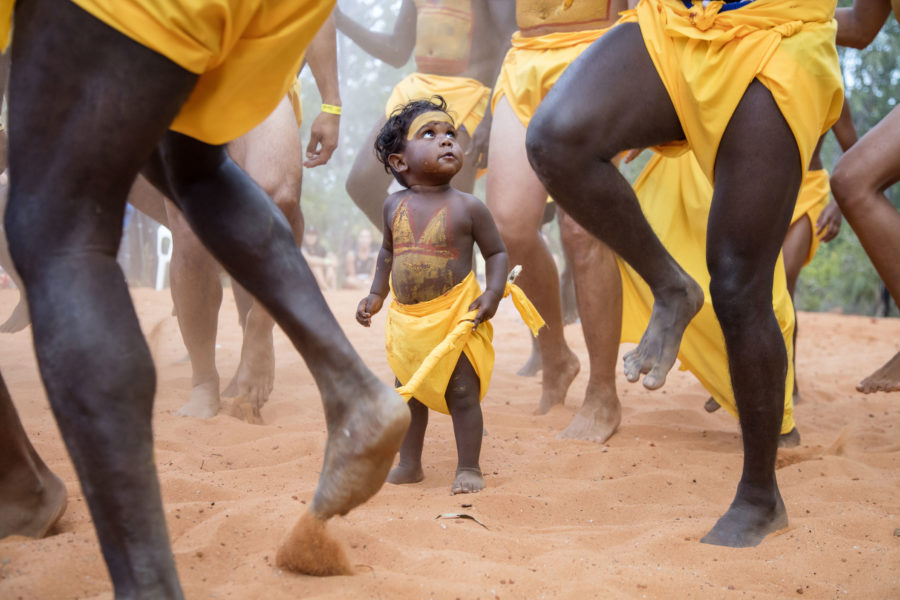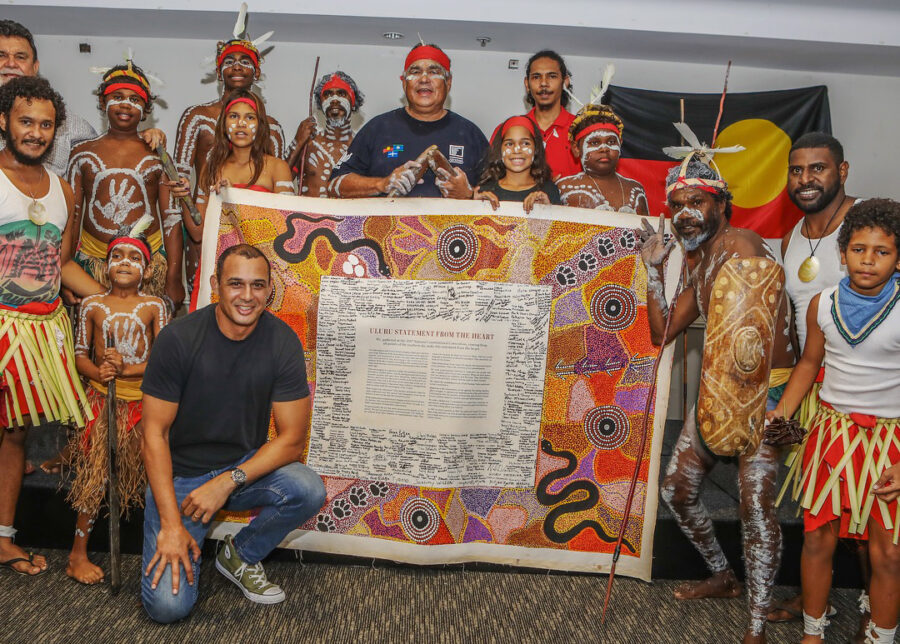Listening to the voices: Sammy Wilson (Tjama Uluru)
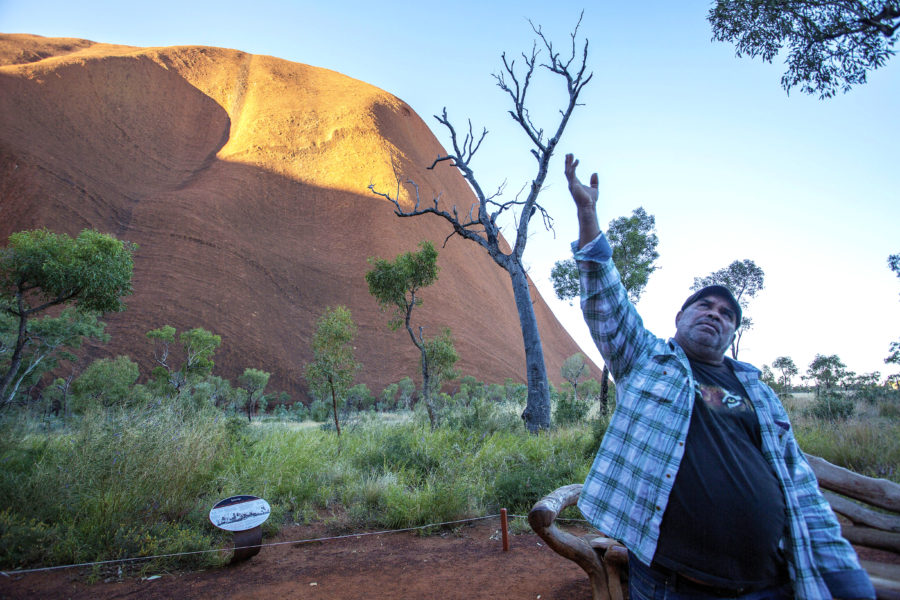
This is the first in a series of interviews between First Nations advocate Thomas Mayo and the Indigenous community leaders he met when he toured Australia in 2019 with the Uluru Statement from the Heart.
Sammy Wilson (Tjama Uluru)
Anangu, Custodian of Uluru
When I flew to Uluru for the First Nations National Constitutional Convention in 2017, I was on a journey with hundreds of other Aboriginal and Torres Strait Islander people. We were coming together to discuss the Australian Constitution, so I spent the flight reading it.
Almost two years later, I travelled to Uluru again. This time, I was alone. My journey to the centre of Australia was to meet one man for the final interview for my book Finding the Heart of the Nation, a man named Sammy Wilson. He is Uluru.
On the short flight between Alice Springs and Uluru, I leant my head against the window to gaze on the country below. I looked down at the patterns of spinifex covering ancient dunes. The dunes looked small, so far down below, like ripples on a beach. Intermittently, rocky outcrops and sparse desert flora dotted the landscape, and I realised I was looking at a living Anangu painting. What I was seeing from high above in the small plane was Anangu law – songlines, Creation stories – Tjukurrpa. It struck me that, as with my flight in 2017, I was passing my time looking at sections of a nation’s constitution. This time though, I thought, I am looking at the original and continuing constitution – one that has existed, according to the common law, since time immemorial.
It was early afternoon when we landed at Uluru. As I stepped from the cool of the cabin, a hot dry wind licked my face. The warmth felt pleasant at first – but not for long. The short walk across the tarmac was all it took for the shade of the terminal to be a welcome comfort. Seeing the familiar airport immediately brought back pleasant memories of 2017 – memories that became more intense and heartfelt when I arrived at the Yulara Resort where about 270 of us had stayed and convened the First Nations National Constitutional Convention. I checked in and went for a walk to revisit more memories. First, I walked to the Uluru Meeting Place. The large convention room where – between massive Aboriginal and Torres Strait Islander flags – we’d shared our regional dialogue outcomes and conducted debate, before achieving a constitutional moment by endorsing the Uluru Statement from the Heart.
Thinking about the positive vibe of that third and final morning brought on goose bumps. Afterwards, I had joined the excited throng of delegates lining up to put our names on a blank canvas. We’d still been congratulating each other, there’d been more hugs – some of us with eyes swollen from crying. I recalled how my face was aching from smiling.
I laughed quietly to myself as I walked past the bar where many of us had celebrated our success until dawn. I tried to be inconspicuous as I took a photo of the quiet little corner where the guitar players had sat strumming, with the rest of us crowded around singing. The corner may have been empty as I stood reminiscing, but I could hear the revelry still echoing around the walls two years on. I smiled. What a fond memory.
My final destination that afternoon was the magnificent and sacred Uluru. Both the rock and the man, Sammy Wilson. In the way of the Anangu, Sammy is the custodian of Uluru because he is the eldest grandson of the late Paddy Uluru. The grandfather and grandson relationship (tjamu) is one of the most significant relationships in Anangu life. It is his relationship with his grandfather that gives Sammy his real name, Tjama Uluru. Sammy lives in the small community of Mutitjulu, the closest community to Uluru. He is a leader of his people in two systems of law, both on the boards and councils that affect his community, and in Anangu Tjukurrpa (Anangu law). The Anangu lands around Uluru and Kata Tjuta were mostly unsuitable to the invading white people’s interests. In 1920 the area was declared part of a larger system of Aboriginal reserves. As with almost all Aboriginal reserves, some of the lands were eventually excised for mining interests. Then, in 1948, a dirt road was built to bring tourists to Uluru. By the 1950s, miners and tourists were consistently occupying and interrupting Anangu life.
Sammy’s father was a man of Scottish descent who wasn’t around for long. Sammy’s skin colour is light, so in his youth, this caused his connection to family and Country to be precarious. He and other light-skinned Aboriginal children were popular targets for child-stealing authorities. They didn’t steal Sammy.
In his youth he walked the songlines and learnt from his grandfather and other Elders in accordance with the Tjukurrpa (Anangu law). He takes the custodianship of his family’s knowledge very seriously. The decision to give the name Uluru to the Uluru Statement from the Heart was made by Sammy and his family, for both spiritual and practical purposes. Sammy wants the power of Uluru to help achieve change. For this reason, I felt there was no more fitting person than Sammy, Tjama Uluru, to give the final interview for my book.
On the drive from Yulara to Uluru to interview Sammy, I took my time to enjoy the incredible landscape. Uluru is famous for its captivating display of brilliant red at the height of the day, and infinite shades of purple as the sun descends. The rock dramatically changes appearance depending on from where it’s viewed. Sammy wanted to show me a new perspective – one that cannot be captured in a photograph. “I’ll take you for a walk, at Mutitjulu Waterhole, show you the story of Kuniya and Liru and explain some things,” he said. I was excited to walk to the site of an epic Creation story with Sammy Wilson. And because he is a very busy man, I was lucky. He is a former chair of the Mutitjulu Community Aboriginal Corporation, the Uluru-Kata Tjuta Board of Management, and the Central Land Council. On the day I visited him, he was between meetings for various of these roles. We picked up some water and hit the road. “I was born over there [he pointed], near the Stuart Highway. I don’t know where the border is, but I was born on the land. Not in a hospital and not far from here. Near De Rose Hill Station.” In Central Australia, 400km isn’t far between communities. “I grew up here on my grandfather’s and great-grandfather’s Country. This place. I went to school little bit everywhere. But my school was the land and the language, and my Elders. And a lot of my school was from tourism,” Sammy said, and laughed. “I teach them about my land, and they teach me too.”
Uluru loomed ahead, a brilliant, bright red. “When I went to school – in the late ’60s, early ’70s maybe – my name was Tjama Uluru. I changed it to Sammy because I was scared of this place, Uluru, when I was a young boy. When they asked me what my last name, I got upset and went home. Mum said to me, ‘What you doing here? You should be in school.’ I said, ‘These mob there, they’re asking me a lot of questions.’ I didn’t want my Uluru name. It’s a powerful place, you know. My stepfather is Wilson. He said, ‘You want to be Wilson?’ I said, ‘Well, yeah.’ He said, ‘Okay then.”’ Sammy laughed. “I was a bit happy! But I’m still Uluru. I know now that this rock is a really special place. It’s who I am.”
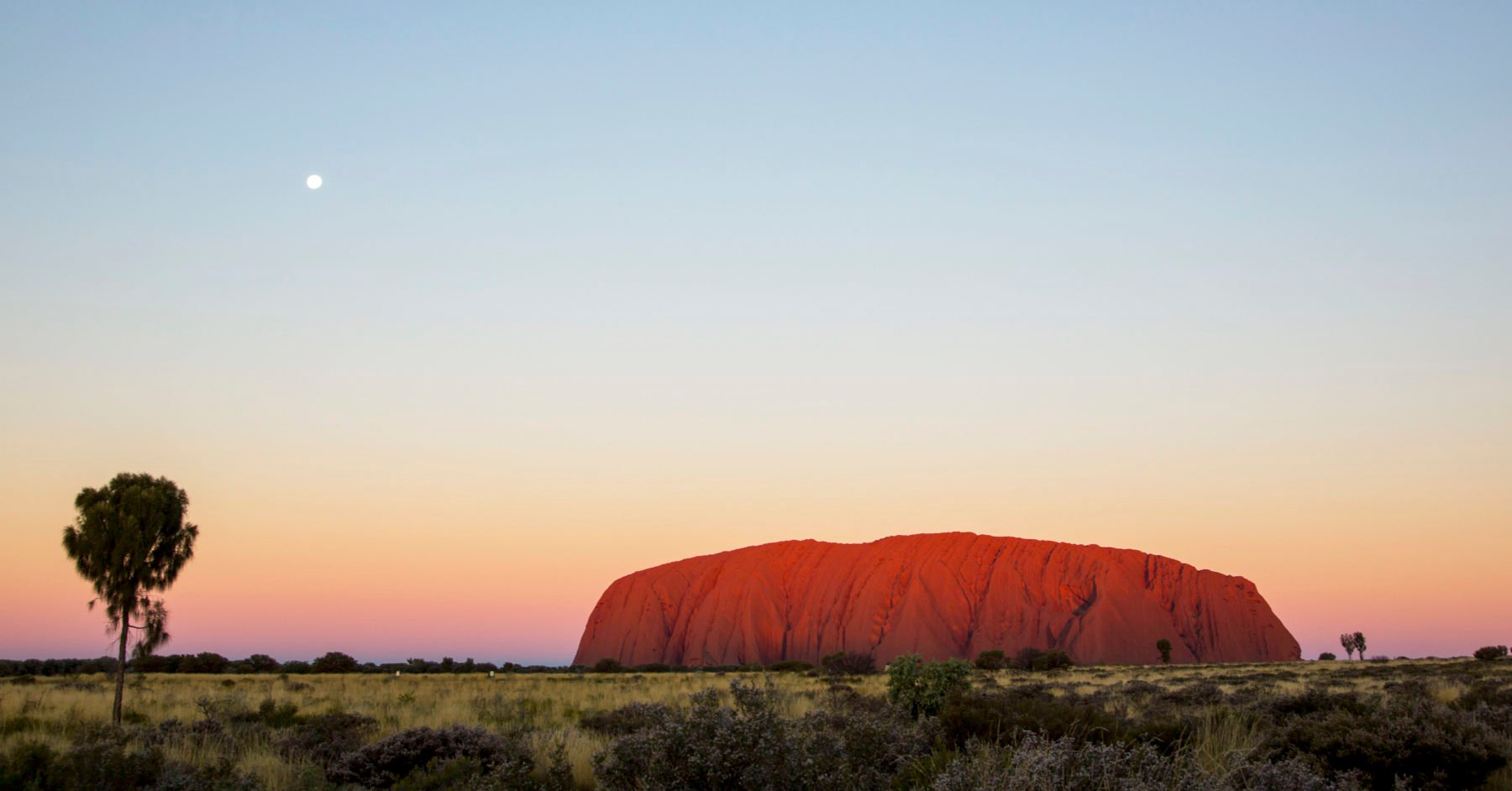
When we stopped at the Mutitjulu car park, Sammy checked that I had my water and we began walking. We casually talked about what had transpired in that special place, both recently and in the Creation. “In the ’30s, my grandfather Paddy Uluru and his brother, there was four of them including one young fella – they was hiding from policemen here because something happened this way [pointing southward]. They speared one cow. They thought it was a monster with its big horns when it came to them at night. Piranpa [white fella] found the wounded cow. So the policemen chased them. They came here, hiding in the rock here, and one of them was shot by the policeman.” It was Paddy’s brother, killed by the piranpa’s bullet. As Sammy spoke, he pointed to the crevices in the great rock where his grandfather had hidden and one of the men had died. It was an eerie feeling, standing where the blood was spilt for colonial ‘justice’. I imagined red dust in the unsettled wake of desperate, scrambling men, indiscriminately fired bullets ricocheting off the smooth rock walls of the shelter, where a man who had played in that place as a child was about to lose his life because an alien milking cow had been wounded. “When night-time come, they escaped. One went west and the other two, my grandfather, went South Australia near Ernabella. My grandfather never came back until the ’50s. He walked back from Mimili with my two uncles, Reggie and Cassidy, who are still living here. The family walked with one camel – something like 350km they walked. When they got here they found that everything is changing. There were tourists everywhere, going in to everything, doing whatever they want. And we had no rights.”
Sammy and I continued down the track towards the waterhole. Excited throngs of tourists chattered loudly as they passed by. They were oblivious to the importance of the man named for the place they’d come to see. I mentioned to Sammy that when I stopped at the waterhole earlier on, I had spent what felt like a full 15 minutes sitting in the shade by myself, with no tourists around me. He laughed and said that I was lucky. Stopping at a bush to pick some small black berries, he told me, “You can eat this one, arnguli. They call it bush plum too.” Sammy put a plum to his mouth and carefully bit into its flesh. I took one from his hand and tasted it. It was a little sweet and a little bitter at the same time, but nice. The path now led along the base of Uluru. I commented on the shape of the base of the rock – it was as though a massive python metres long with a body much bigger than me had slithered by, indenting its shape in the hard red surface. Sammy smiled. “Uwa! [Yes!] That’s her! That’s her now, Kuniya the woma python, she come from the east. She had a bad feeling.” Sammy rubbed his belly. “She was wondering, Why I feel like this? The feeling was because her nephew needed help. A war party, the Liru snake men, had followed him from the west.”
Kuniya’s impression in the rock led to the small Mutitjulu Waterhole tucked into a deep bay in the rock. In the afternoon, the cosy little place by the waterhole is cool and shady, and serene if you are lucky enough to have more than a moment alone. Sammy told me how saddened his grandfather was when he returned to see the careless desecration of deeply sacred sites on and around Uluru. The tourism operators and park rangers paid little regard to the old Aboriginal man. The Anangu people had become outcasts, etching out a meagre living making artefacts and selling them to tourists.
Sammy sited the 1967 Referendum for Aboriginal citizenship rights as the catalyst for change. “Then, in 1967, everything changed after that referendum. Some people wanted to find my grandfather to talk about this place. They wanted to know about his story to help us get the land rights. Remember Sir Doug Nicholls? He was in the government in Adelaide. He was the governor of SA. He played for Fitzroy.” Sammy laughed. “Sometimes when I tell people from Victoria or Adelaide, they say, ‘Yeah, he used to play with my grandfather!’ Because Sir Doug Nicholls used to play AFL! I got his old photo where he is talking to my grandfather in Mimili in South Australia.”
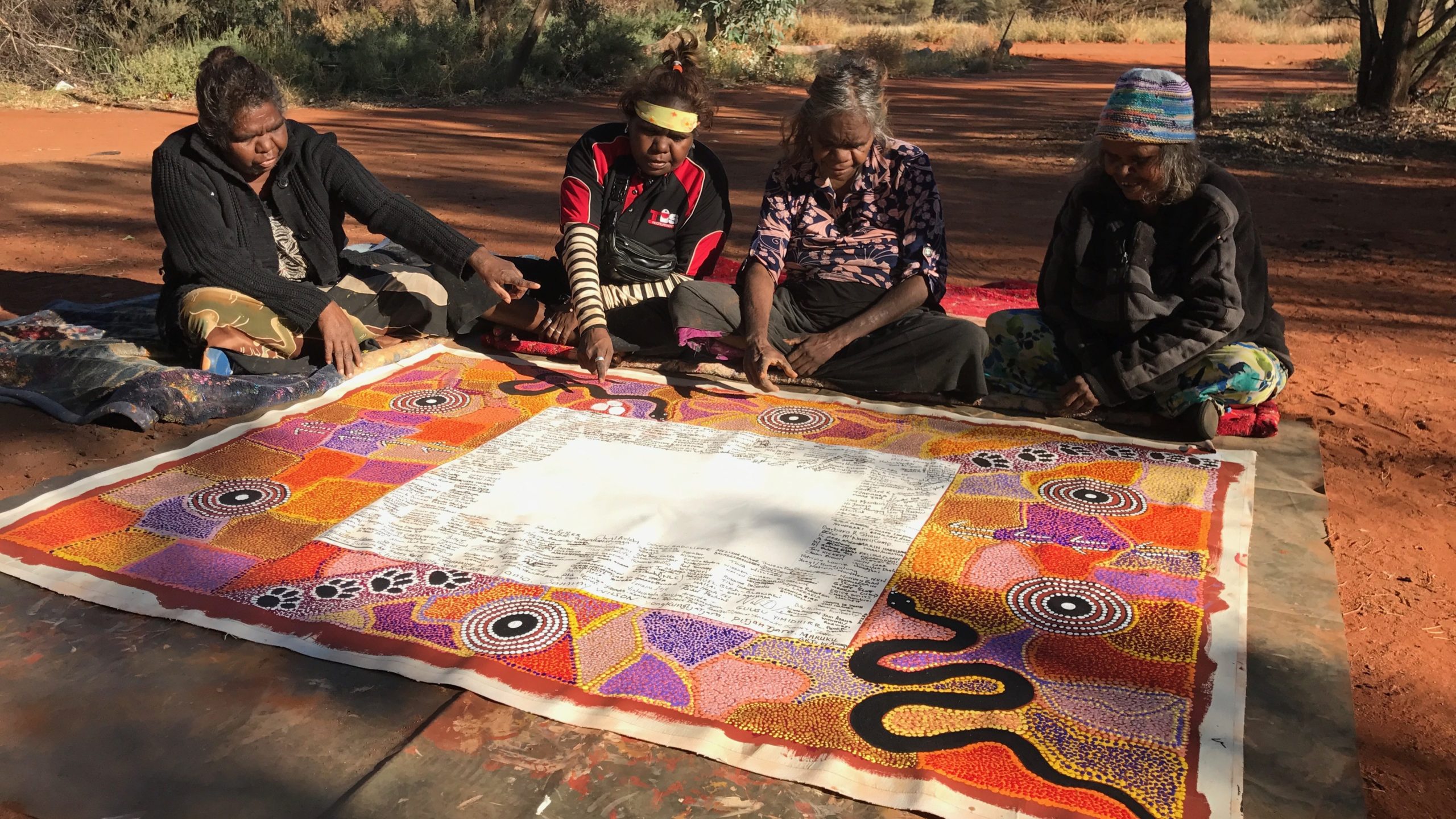
Sammy’s grandfather, along with other strong Anangu Elders, worked tirelessly to change attitudes towards their custodianship, and when the Aboriginal Land Rights Act (NT) 1976 was enacted, they sought to reclaim their land. The Northern Territory government, pastoralists and the tourism industry fought tooth and nail against any land claim. But in 1983 the newly elected prime minister Bob Hawke announced his government would amend the Aboriginal Land Rights Act to return the title for Uluru-Kata Tjuta National Park to the Traditional Owners. Sadly, Sammy’s beloved grandfather Paddy had passed away by then. As we walked back to the car, Sammy pointed out another part of the Kuniya Liru Tjukurrpa. “That’s her again, coming from the other side. When she found out her bad feeling was the Liru snake men had speared the woma python, her nephew, she performed a special ritual to give herself power. Here, have a look at them marks. At the bottom of the rock there, that’s where she knelt down in the sand. She is kneeling and covering herself with the sand. It’s part of a ritual. That’s why it is Muti. Muti means “knee”; tjunu means “put down”. Muti-tjunu is “kneel down” in Mutitjulu. When she kneel down, that’s her knees. When it rains, the other holes change colours, but these ones, always the same.”
A little further on he pointed to marks high up on the rock wall to the west of the waterhole. “Up there, look, you see her war-club marks. You can see where Kuniya hit the snake man, Liru.” Sammy guided me to a small cave with artwork that is probably tens of thousands of years old. He explained that the drawings – circles within circles, arches and familiar shapes – are more than art. “It’s not an art. It’s a written language. Before all these letters come, this was part of our communication. The circles and lines show where the waterhole is, or for hunting and gathering.”
Suddenly a fresh wind gust blew. It felt odd. I had goose bumps. Sammy laughed. He said, “Same as when Oprah Winfrey came here! The wind blew like this. She said, ‘Oi, I can feel it! Something is here!’”
Back at the ranger station, I sat with Sammy before his next meeting. An elderly Anangu man, also there for the meeting, came and sat with us. We chatted about the ceremony in Mutitjulu for the Uluru First Nations Constitutional Convention, the inma (ceremony), where the Torres Strait Islanders and Yolŋu had danced on the same grounds as his people. We also talked fondly about the moment when we had endorsed the Uluru Statement; as Sammy said, “We were all crying.”
In between my questions and Sammy’s answers, he and the elderly Anangu man spoke in Pitjantjatjara Yankunytjatjara. I thought perhaps Sammy was translating our conversation. I could pick up the occasional word. I heard Tjukurrpa and Voice mentioned several times. Before I realised it, Sammy was talking to me again. “You see where I’m living here? There’s a rock here, hmm? And we live in a hard place… We’re between a rock and a hard place! You like that?” He laughed.
Then he said, seriously: “When all the peoples came here, whether they from here or another country – Victoria or Tasmania or South Australia or wherever – we came together to get our voices in there to the government, or we’ll be fighting and arguing with each other while the government is laughing at us. We all came together as one,” Sammy said to me. “Tjungu means one people, together, with the one Voice. Anangu gotta be in Canberra together with other First Nations – stronger – doesn’t matter different language, different culture, but one Tjukurrpa, one story, One Voice,” said Uluru.
